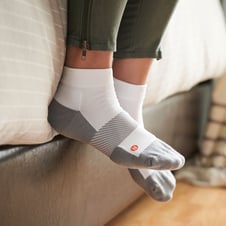Preventing blisters is vital for anyone spending time outdoors in hot weather. Whether you're hiking through the wilderness, exploring a bustling city, or simply taking a leisurely stroll, avoiding painful blisters is crucial.
While blisters can happen year-round, they're especially common in hot weather when sweat and friction can make matters worse. In this guide, we'll explore why choosing the right socks and shoes is crucial for preventing blisters in warmer weather. Additionally, we'll provide practical tips to keep your feet happy and free from blisters..png?width=618&height=348&name=Blog%20Banner%20Image%20(10).png)
Understanding Blisters
A thorough understanding of blister formation and their increased prevalence in hot weather is crucial before exploring preventative measures.
- Friction: Blisters form when repeated rubbing, like ill-fitting shoes against your skin, creates friction. This friction separates the outer layers of your skin, causing a fluid-filled pocket to form – the blister.
- Moisture: Sweat softens the skin, making it more susceptible to friction and increasing the likelihood of blisters.
- Heat: Hot weather can exacerbate sweating, leading to damp feet that are more prone to blister formation.
- Ill-fitting Footwear: Shoes that are too tight or too loose can rub against the skin, creating friction points that may result in blisters.
Hot weather increases blister risk. To combat this, proper sock and shoe selection is crucial.
Choosing the Right Socks
Selecting the appropriate socks is the first line of defense against blisters in hot weather. Here's what to look for when choosing socks for blister prevention:

- Moisture-Wicking Materials - Opt for socks made from moisture-wicking materials like merino wool or synthetic blends. These fabrics help draw moisture away from the skin, keeping your feet dry and reducing the risk of blisters.
- Seamless Construction - Look for socks with seamless toe closures to minimize friction points that can lead to blisters. To maximize comfort during hot weather activities, seamless socks prevent rubbing and irritation.
- Proper Fit - Ensure your socks fit snugly without being too tight. Select socks that provide a secure and comfortable fit, minimizing slippage during activity.
- Cushioning and Padding - Consider socks with extra cushioning in high-friction areas such as the heel and ball of the foot. Padded socks provide added protection against blisters and help absorb shock during walking or hiking.
Selecting the Right Shoes
In addition to choosing the right socks, selecting suitable footwear is essential for blister prevention in hot weather. Here's what to consider when choosing shoes:
- Breathable Materials - Opt for shoes made from breathable materials such as mesh or lightweight fabrics. Breathable shoes allow air to circulate around your feet, helping to keep them cool and dry in hot weather.
- Proper Fit - Select footwear with proper fit and ample toe box space. Avoid shoes that are too tight or too loose, as they can cause friction and increase the risk of blisters. Make sure there is enough space between your toes and the end of the shoe to prevent rubbing.
- Supportive Construction - Look for shoes with adequate arch support and cushioning to help distribute pressure evenly across your feet. Proper support reduces strain on the feet and minimizes the risk of blisters, especially during long periods of walking or hiking in hot weather.
- Ventilation - Select shoes with ventilation features such as mesh panels or perforations. Ventilated shoes allow heat and moisture to escape, helping to prevent sweat buildup and reduce the risk of blisters.
Practical Tips for Blister Prevention
In addition to choosing the right socks and shoes, here are some practical tips for preventing blisters in hot weather:
- Keep Your Feet Clean and Dry: Wash your feet regularly and thoroughly dry them, especially between the toes, to prevent moisture buildup.
- Use Anti-Chafing Products: Use a lubricant or anti-chafing balm on areas prone to friction, like the heels and sides of your feet.
- Change Socks Frequently: Bring extra pairs of socks and change them regularly, especially if your feet become sweaty or damp.
- Take Breaks: If possible, take regular breaks to allow your feet to cool down and air out.
- Inspect Your Feet: Make it a habit to check your feet often for any signs of irritation or hot spots, and take immediate action to prevent blisters.
Conclusion
Preventing blisters in hot weather requires careful consideration of both socks and shoes. Selecting moisture-wicking socks and breathable, supportive shoes can reduce blister risk, ensuring comfort during outdoor activities.
Following simple advice such as keeping your feet clean and dry, using anti-chafing products, and taking breaks can lower the risk of blisters. With the right socks, shoes, and precautions, you can keep your feet comfortable and blister-free in hot weather.


.jpg?width=225&height=225&name=CJO05933%20(1).jpg)
.png?width=116&name=Anodyne_circle_1_logo%20(2).png)
